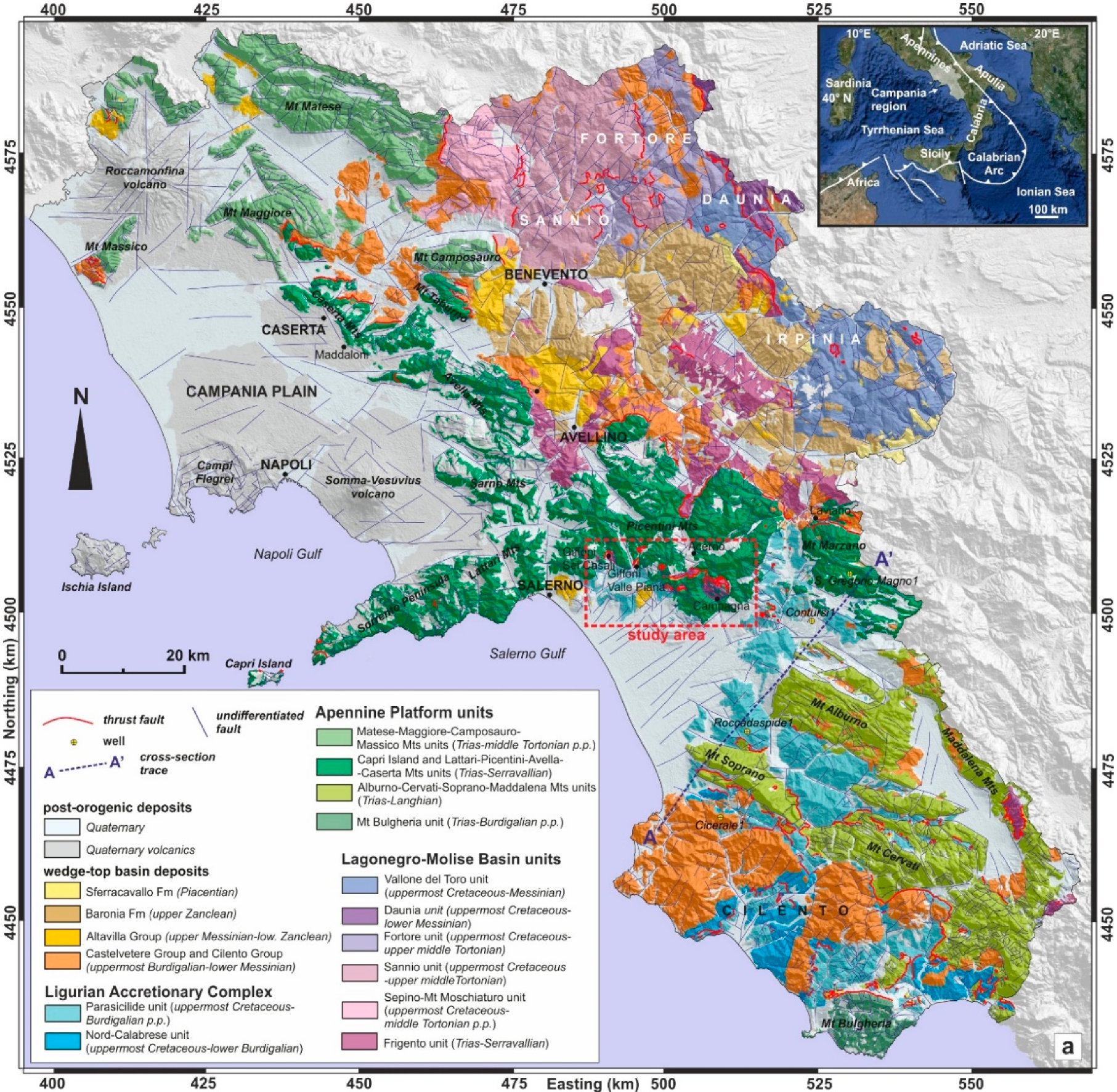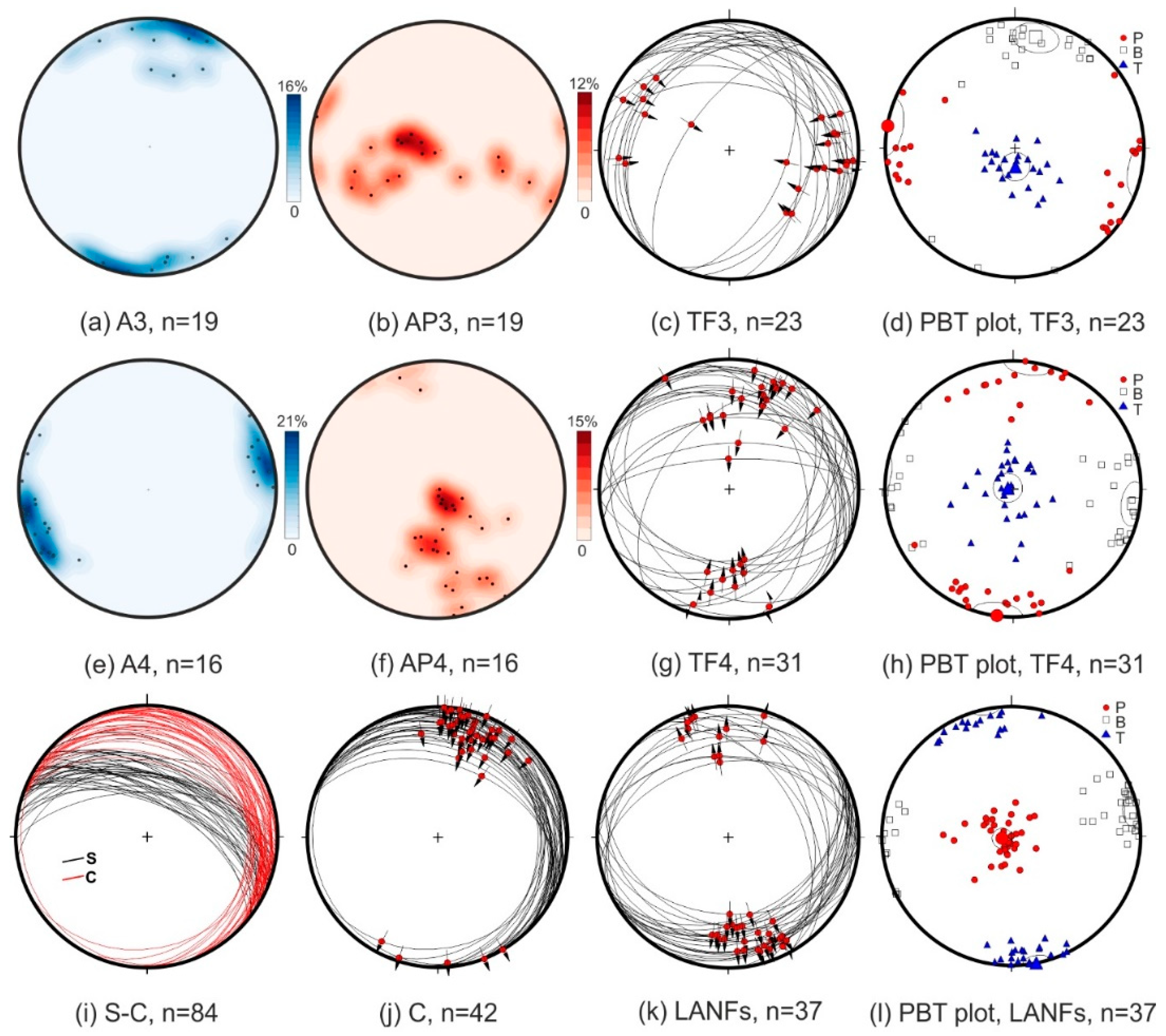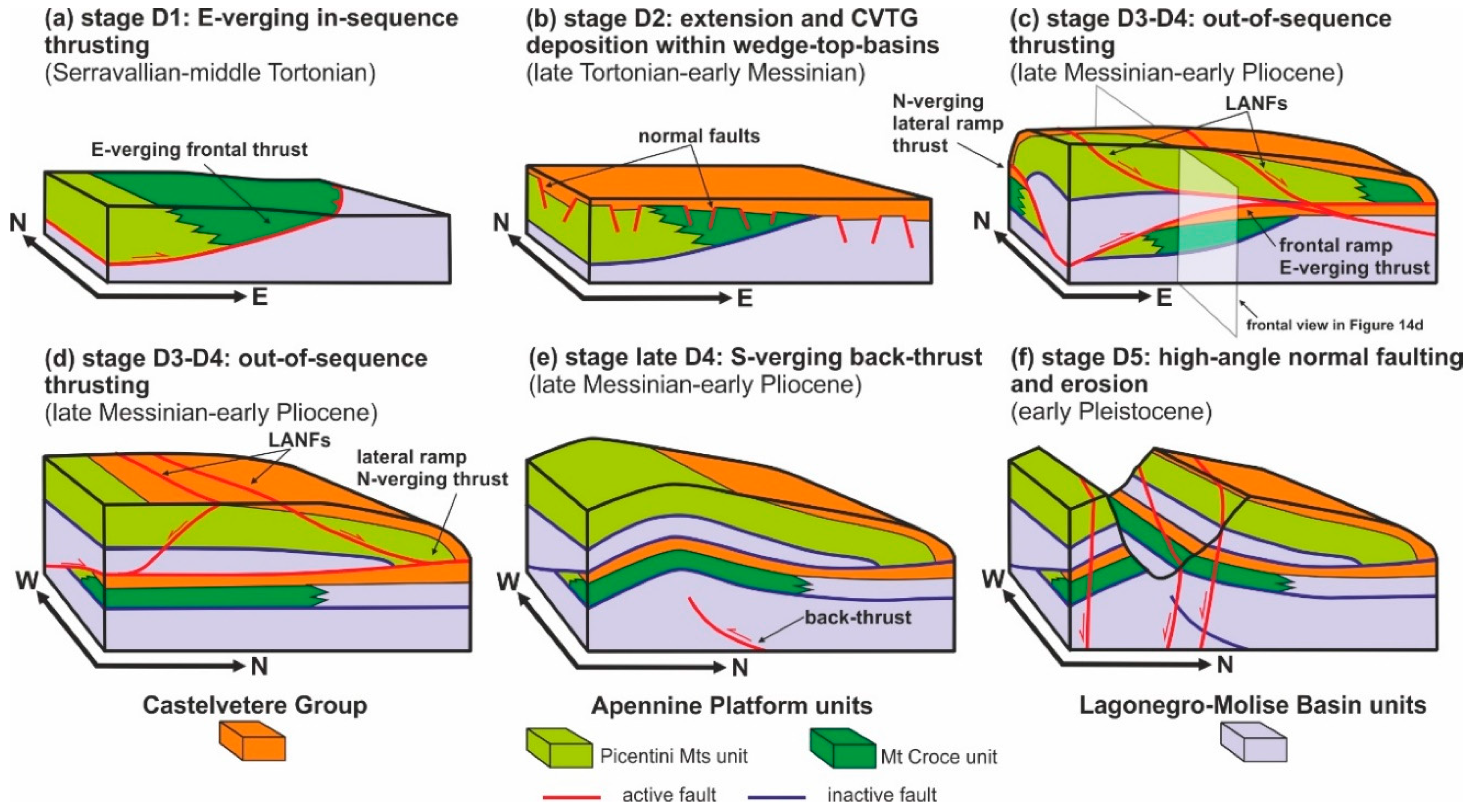Structural and Stratigraphic Setting of Campagna and Giffoni Tectonic Windows: New Insights on the Orogenic Evolution of the Southern Apennines (Italy)
Abstract
:1. Introduction
2. Geological Setting
3. Structures
3.1. Campagna Tectonic Window
3.2. Giffoni Tectonic Window
4. Discussion
5. Conclusions
Author Contributions
Funding
Acknowledgments
Conflicts of Interest
References
- Noguera, A.; Rea, G. Deep structure of the Campanian–Lucanian Arc (Southern Apennine, Italy). Tectonophysics 2000, 324, 239–265. [Google Scholar] [CrossRef]
- Mazzotti, A.; Stucchi, E.; Fradelizio, G.L.; Zanzi, L.; Scandone, P. Seismic exploration in complex terrains: A processing experience in the Southern Apennines. Geophysics 2000, 65, 1402–1417. [Google Scholar] [CrossRef]
- Shiner, P.; Beccacini, A.; Mazzoli, S. Thin-skinned versus thick-skinned structural models for Apulian carbonate reservoirs: Constraints from the Val d’Agri Fields, S Apennines, Italy. Mar. Pet. Geol. 2004, 21, 805–827. [Google Scholar] [CrossRef]
- Butler, R.W.H.; Mazzoli, S.; Corrado, S.; Dedonatis, M.; Dibucci, D.; Gambini, R.; Naso, G.; Nicolai, C.; Scrocca, D.; Shiner, P.; et al. Applying thickskinned tectonic models to the Apennine thrust belt of Italy: Limitations and implications. In Thrust Tectonics and Hydrocarbon Systems; McClay, K.R., Ed.; The American Association of Petroleum Geologists: Tulsa, OK, USA, 2004; pp. 647–667. [Google Scholar]
- Scrocca, D.; Carminati, E.; Doglioni, C. Deep structure of the southern Apennines, Italy: Thin-skinned or thick-skinned? Tectonics 2005, 24. [Google Scholar] [CrossRef]
- Mazzoli, S.; D’Errico, M.; Aldega, L.; Corrado, S.; Invernizzi, C.; Shiner, P.; Zattin, M. Tectonic burial and ‘young’ (<10 Ma) exhumation in the southern Apennines fold and thrust belt (Italy). Geology 2008, 36, 243–246. [Google Scholar] [CrossRef]
- Vitale, S.; Ciarcia, S. Tectono-stratigraphic and kinematic evolution of the southern Apennines/Calabria–Peloritani Terrane system (Italy). Tectonophysics 2013, 583, 164–182. [Google Scholar] [CrossRef]
- Vitale, S.; Ciarcia, S. Tectono-stratigraphic setting of the Campania region (southern Italy). J. Maps 2018, 14, 9–21. [Google Scholar] [CrossRef]
- Sabbatino, M.; Vitale, S.; Tavani, S.; Consorti, L.; Corradetti, A.; Cipriani, A.; Arienzo, I.; Parente, M. Constraining the onset of flexural subsidence and peripheral bulge extension in the Miocene foreland of the southern Apennines (Italy) by Sr-isotope stratigraphy. Sediment. Geol. 2020, 401, 105634. [Google Scholar] [CrossRef]
- Mostardini, F.; Merlini, S. Appennino centro-meridionale: Sezioni Geologiche e proposta di modello strutturale. Mem. Soc. Geol. Ital. 1986, 35, 177–202. (In Italian) [Google Scholar]
- Vitale, S.; Prinzi, E.P.; Tramparulo, F.D.A.; De Paola, C.; Di Maio, R.; Piegari, E.; Sabbatino, M.; Natale, J.; Notaro, P.; Ciarcia, S. Late Miocene-Early Pliocene Out-of-Sequence Thrusting in the Southern Apennines (Italy). Geosciences 2020, 10, 301. [Google Scholar] [CrossRef]
- Bally, A.W.; Gordy, P.L.; Stewart, G.A. Structure, seismic data and orogenic evolution of the southern Canadian Rocky Mountains. Bull. Can. Pet. Geol. 1966, 14, 337–381. [Google Scholar]
- Ghisetti, F.; Barchi, M.; Bally, A.W.; Moretti, I.; Vezzani, L. Conflicting balanced structural sections across the Central Apennines (Italy): Problems and implications. In Generation, Accumulation and Production of Europe’s Hydrocarbons; European Association of Petroleum Geoscientists, Special Publication; Spencer, A.M., Ed.; Springer: Berlin/Heidelberg, Germany, 1993; Volume 3, pp. 219–231. [Google Scholar]
- Vitale, S.; Tramparulo, F.D.A.; Ciarcia, S.; Amore, F.O.; Prinzi, E.P.; Laiena, F. The northward tectonic transport in the southern Apennines: Examples from the Capri Island and western Sorrento Peninsula (Italy). Int. J. Earth Sci. 2017, 106, 97–113. [Google Scholar] [CrossRef]
- Vitale, S.; Prinzi, E.P.; Ciarcia, S.; Sabbatino, M.; Tramparulo, F.D.A.; Verazzo, G. Polyphase out-of-sequence thrusting and occurrence of marble detritus within the wedge-top basin deposits in the Mt. Massico (southern Apennines): Insights into the late Miocene tectonic evolution of the central Mediterranean. Int. J. Earth Sci. 2019, 108, 501–519. [Google Scholar] [CrossRef]
- Bertello, F.; Fantoni, R.; Franciosi, R.; Gatti, V.; Ghielmi, M.; Pugliese, A. From Thrust and-Fold Belt to Foreland: Hydrocarbon Occurrences in Italy. In Proceedings of the 7th Petroleum Geology Conference, London, UK, 30 March–2 April 2009; Vining, B.A., Pickering, S.C., Eds.; Geological Society of London: London, UK, 2010; pp. 113–126. [Google Scholar]
- Smeraglia, L.; Aldega, L.; Billi, A.; Carminati, E.; Di Fiore, F.; Gerdes, A.; Albert, R.; Rossetti, F.; Vignaroli, G. Development of an Intrawedge Tectonic Mélange by Out-of-Sequence Thrusting, Buttressing, and Intraformational Rheological Contrast, Mt. Massico Ridge, Apennines, Italy. Tectonics 2019, 38, 1223–1249. [Google Scholar] [CrossRef]
- Ietto, A. Su alcune particolari strutture connesse alla tettonica di sovrascorrimento dei Monti Picentini (Appennino Meridionale). Boll. Soc. Nat. Napoli 1965, 74, 65–85. (In Italian) [Google Scholar]
- Scandone, P.; Sgrosso, I.; Vallario, A. Finestra tettonica nella serie calcareo-silico-marnosa lucana presso Campagna (Monti Picentini, Salerno). Boll. Soc. Nat. Napoli 1967, 76, 3–10. (In Italian) [Google Scholar]
- Turco, E. La finestra tettonica di Campagna (M. Picentini, Salerno). Boll. Soc. Nat. Napoli 1976, 85, 639–665. (In Italian) [Google Scholar]
- Pappone, G.; Ferranti, L. Thrust tectonics in the Picentini Mountains, Southern Apennines, Italy. Tectonophysics 1995, 252, 331–348. [Google Scholar] [CrossRef]
- Ferranti, L.; Oldow, J.S. History and tectonic implications of low-angle detachment faults and orogen parallel extension, Picentini Mountains, Southern Apennines fold and thrust belt, Italy. Tectonics 1999, 18, 498–526. [Google Scholar] [CrossRef]
- ISPRA. Carta Geologica d’Italia Alla Scala 1:50.000, Foglio Foglio 467 “Salerno”. 2020. Available online: http://www.isprambiente.gov.it/Media/carg/467_SALERNO/Foglio.html (accessed on 2 August 2020).
- ISPRA. Carta Geologica d’Italia Alla Scala 1:50.000, Foglio Foglio 468 “Eboli”. 2020. Available online: http://www.isprambiente.gov.it/Media/carg/468_EBOLI/Foglio.html (accessed on 2 August 2020).
- Ciarcia, S.; Vitale, S.; Di Staso, A.; Iannace, A.; Mazzoli, S.; Torre, M. Stratigraphy and tectonics of an Internal Unit of the southern Apennines: Implications for the geodynamic evolution of the peri-Tyrrhenian mountain belt. Terra Nova 2009, 21, 88–96. [Google Scholar] [CrossRef]
- Ciarcia, S.; Mazzoli, S.; Vitale, S.; Zattin, M. On the tectonic evolution of the Ligurian accretionary complex in southern Italy. Geol. Soc. Am. Bull. 2012, 124, 463–483. [Google Scholar] [CrossRef]
- Vitale, S.; Ciarcia, S.; Mazzoli, S.; Iannace, A.; Torre, M. Structural analysis of the ‘Internal’ Units of Cilento, Italy: New constraints on the Miocene tectonic evolution of the southern Apennine accretionary wedge. Comptes Rendus Geosci. 2010, 342, 475–482. [Google Scholar] [CrossRef]
- Vitale, S.; Ciarcia, S.; Mazzoli, S.; Zaghloul, M. Tectonic evolution of the ‘Liguride’ accretionary wedge in the Cilento area, southern Italy: A record of early Apennine geodynamics. J. Geodyn. 2011, 51, 25–36. [Google Scholar] [CrossRef] [Green Version]
- Vitale, S.; Fedele, L.; Tramparulo, F.D.A.; Ciarcia, S.; Mazzoli, S.; Novellino, A. Structural and petrological analyses of the Frido Unit (southern Italy): New insights into the early tectonic evolution of the southern Apennines–Calabrian Arc system. Lithos 2013, 219–235. [Google Scholar] [CrossRef]
- Vitale, S.; Ciarcia, S.; Tramparulo, F.D.A. Deformation and stratigraphic evolution of the Ligurian Accretionary Complex in the southern Apennines (Italy). J. Geodyn. 2013, 66, 120–133. [Google Scholar] [CrossRef]
- Vitale, S.; Ciarcia, S.; Fedele, L.; Tramparulo, F.D.A. The Ligurian oceanic successions in southern Italy: The key to decrypting the first orogenic stages of the southern Apennines-Calabria chain system. Tectonophysics 2019, 750, 243–261. [Google Scholar] [CrossRef]
- Scandone, P.; Sgrosso, I. Il Mesozoico nel gruppo montuoso dell’Accellica (M. Picentini-Salerno). Mem. Soc. Geol. Ital. 1964, 4, 1–8. (In Italian) [Google Scholar]
- Scandone, P.; Sgrosso, I. Sulla paleogeografia della Penisola Sorrentina dal Cretacico superiore al Miocene. Boll. Soc. Nat. Napoli 1965, 74, 159–177. (In Italian) [Google Scholar]
- Servizio Geologico d’Italia, Geological Map of Italy, Scale 1:100,000, Sheets 186 S. Angelo de’ Lombardi and 198 Eboli. 1970. Available online: http://193.206.192.231/carta_geologica_italia/sud.htm (accessed on 2 August 2020).
- D’Argenio, B.; Pescatore, T.; Scandone, P. Schema geologico dell’Appennino meridionale (Campania e Lucania). In Atti del Conv. Moderne Vedute Sulla Geologia dell’Appennino; Atti Accademia Nazionale dei Lincei: Rome, Italy, 1973; pp. 49–72. (In Italian) [Google Scholar]
- Scandone, P.; Sgrosso, I. La successione miocenica dell’alta Vallimala nella finestra tettonica di Campagna (Monti Picentini). Boll. Soc. Geol. Ital. 1974, 93, 1043–1047. (In Italian) [Google Scholar]
- Pagliaro, S. Geologia della Finestra Tettonica di Campagna (Monti Picentini–Salerno); Arte Tipografica Editrice: Napoli, Italy, 2003; pp. 1–43. [Google Scholar]
- Patacca, E. Stratigraphic constraints on the CROP-04 seismic line interpretation: San Fele 1, Monte Foi 1 and San Gregorio Magno 1 wells (Southern Apennines, Italy). Boll. Soc. Geol. Ital. 2007, 7, 185–239. [Google Scholar]
- Bonardi, G.; Ciarcia, S.; Di Nocera, S.; Matano, F.; Sgrosso, I.; Torre, M. Carta delle principali unità cinematiche dell’Appennino meridionale. Nota illustrativa. Ital. J. Geosci. 2009, 128, 47–60. [Google Scholar]
- Pescatore, T.; Sgrosso, I.; Torre, M. Lineamenti di tettonica e sedimentazione nel Miocene dell’Appennino campano-lucano. Mem. Soc. Nat. Napoli 1970, 78, 337–408. (In Italian) [Google Scholar]
- Cocco, E.; Cravero, E.; Ortolani, F.; Pescatore, T.; Russo, M.; Torre, M.; Coppola, L. Le unità irpine nell’area a nord di Monte Marzano, Appennino Meridionale. Mem. Soc. Geol. Ital. 1974, 13, 607–654. (In Italian) [Google Scholar]
- Dazzaro, L.; Di Nocera, S.; Pescatore, T.; Rapisardi, L.; Romeo, M.; Russo, B.; Senatore, M.R.; Torre, M. Geologia del margine della catena appenninica tra il F. Fortore ed il T. Calaggio (Monti della Daunia—Appennino Meridionale). Mem. Soc. Geol. Ital. 1988, 41, 411–422. (In Italian) [Google Scholar]
- Basso, C.; Ciampo, G.; Ciarcia, S.; Di Nocera, S.; Matano, F.; Torre, M. Geologia del settore irpino-dauno dell’Appennino Meridionale: Unità meso-cenozoiche e vincoli stratigrafici nell’evoluzione tettonica mio-pliocenica. Studi Geol. Camerti 2002, 1, 7–27. (In Italian) [Google Scholar]
- Mattioni, L.; Shiner, P.; Tondi, E.; Vitale, S.; Cello, G. The Argille Varicolori Unit of Lucania (Italy): A record of tectonic offscraping and gravity sliding in the Mesozoic-Tertiary Lagonegro Basin, southern Apennines. In Geology and Active Tectonics of the Western Mediterranean Region and North Africa; Special Publication; Moratti, G., Chalouan, A., Eds.; Geological Society of London: London, UK, 2006; Volume 262, pp. 277–288. [Google Scholar]
- Hippolyte, J.-C.; Angelier, J.; Roure, F. A major geodynamic change revealed by Quaternary stress patterns in the southern Apennines (Italy). Tectonophysics 1994, 230, 199–210. [Google Scholar] [CrossRef]
- Ramsay, J.G. Folding and Fracturing of Rocks; McGraw Hill: New York, NY, USA, 1967. [Google Scholar]
- Angelier, J.; Mechler, P. Sur une méthode graphique de recherche des contraintes principales également utilisable en tectonique et en séismologie: La méthode des diédres droits. Bull. Soc. Géol. Fr. 1977, 19, 1309–1318. (In French) [Google Scholar] [CrossRef]
- Reiter, F.; Acs, P. TectonicsFP. Software for Structural Geology. Innsbruck University, Austria, 1996–2020. Available online: https://github.com/freiter/TectonicsFP/releases (accessed on 2 August 2020).
- Vitale, S.; Amore, O.F.; Ciarcia, S.; Fedele, L.; Grifa, C.; Prinzi, E.P.; Tavani, S.; Tramparulo, F.D.A. Structural, stratigraphic, and petrological clues for a Cretaceous-Paleogene abortive rift in the southern Adria domain (southern Apennines, Italy). Geol. J. 2017, 53, 660–681. [Google Scholar] [CrossRef]
- Corrado, S.; Aldega, L.; Perri, F.; Critelli, S.; Muto, F.; Schito, A.; Tripodi, V. Detecting syn-orogenic extension and sediment provenance of the Cilento wedge top basin (southern Apennines, Italy): Mineralogy and geochemistry of fine-grained sediments and petrography of dispersed organic matter. Tectonophysics 2019, 750, 404–418. [Google Scholar] [CrossRef]
- Ogniben, L. Flysch miocenico autoctono e parautoctono e argille scagliose alloctone nella zona di Caiazzo (Caserta). Boll. Soc. Geol. Ital. 1956, 75, 169–179. (In Italian) [Google Scholar]
- Critelli, S.; Le Pera, E. La Formazione di Castelvetere nell’evoluzione petrostratigrafica dell’avanfossa del Tortoniano-Messiniano dell’Appennino Meridionale. Boll. Soc. Geol. Ital. 1995, 114, 615–634. (In Italian) [Google Scholar]
- Santo, A. Le ruditi dei Monti Alburni nel quadro dell’evoluzione altomiocenica dell’Appennino campano. Boll. Soc. Geol. Ital. 1996, 115, 519–528. (In Italian) [Google Scholar]
- Cerisola, R.; Montone, P. Analisi strutturale di un settore della catena dei Monti Ausoni–Aurunci (Lazio, Italia centrale). Boll. Soc. Geol. Ital. 1992, 111, 449–457. (In Italian) [Google Scholar]
- Naso, G.; Tallini, M.; Tozzi, M. Caratteristiche geologico-strutturali dell’area di Miranda (Isernia): Un contributo alla comprensione dei rapporti tra le falde molisane e avanfossa del Messiniano-Pliocene inferiore. Mem. Soc. Geol. Ital. 1995, 114, 423–441. (In Italian) [Google Scholar]
- Scrocca, D.; Tozzi, M.; Parotto, M. Assetto strutturale del settore compreso tra il Matese, Le Mainarde e l’Unita’ di Frosolone. Implicazioni per l’evoluzione neogenica del sistema di sovrascorrimenti nell’Appennino centro-settentrionale. Studi Geol. Camerti 1995, 2, 407–418. (In Italian) [Google Scholar]
- De Corso, S.; Scrocca, D.; Tozzi, M. Geologia dell’anticlinale del Matese e implicazioni per la tettonica dell’Appennino molisano. Boll. Soc. Geol. Ital. 1998, 117, 419–441. (In Italian) [Google Scholar]
- Patacca, E.; Scandone, P. Geology of southern Apennines. Boll. Soc. Geol. Ital. 2007, 7, 75–119. [Google Scholar]
- ViDEPI. 2020. Available online: https://www.videpi.com/videpi/pozzi/pozzi.asp (accessed on 2 August 2020).
- Scrocca, D.; Sciamanna, S.; Di Luzio, E.; Tozzi, M.; Nicolai, C.; Gambini, R. Structural setting along the CROP-04 deep seismic profile (Southern Apennines—Italy). Boll. Soc. Geol. Ital. 2007, 7, 283–296. [Google Scholar]
- Ferranti, L.; Oldow, J.S.; Sacchi, M. Pre-Quaternary orogen-parallel extension in the Southern Apennine belt, Italy. Tectonophysics 1996, 260, 325–347. [Google Scholar] [CrossRef]
- Casciello, E.; Cesarano, M.; Pappone, G. Extensional detachment faulting on the Tyrrhenian margin of the southern Apennines contractional belt (Italy). J. Geol. Soc. 2006, 163, 617–629. [Google Scholar] [CrossRef]
- Mazzoli, S.; Aldega, L.; Corrado, S.; Invernizzi, C.; Zattin, M. Pliocene-quaternary thrusting, syn-orogenic extension and tectonic exhumation in the Southern Apennines (Italy): Insights from the Monte Alpi area. In Styles of Continental Contraction; Special Paper; Mazzoli, S., Butler, R.W.H., Eds.; Geological Society of America: Boulder, CO, USA, 2006; Volume 414, pp. 55–77. [Google Scholar]
- Carrara, C.; Serva, L. I ciottoli contenuti nei flysch cretacico-paleogenici e miocenici e nei depositi post-tortoniani dell’Appennino meridionale. Loro significato paleotettonico. Boll. Soc. Geol. Ital. 1982, 101, 441–496. (In Italian) [Google Scholar]
- Critelli, S.; Le Pera, E. Tectonic Evolution of the Southern Apennines Thrust-Belt (Italy) as Reflected in Modal Compositions of Cenozoic Sandstone. J. Geol. 1995, 103, 95–105. [Google Scholar] [CrossRef]
- Cinque, A.; Guida, F.; Russo, F.; Santangelo, N. Dati cronologici e stratigrafici su alcuni depositi continentali della piana Piana del F. Sele: I Conglomerati di Eboli. Geogr. Fis. Din. Quat. 1988, 1, 39–44. (In Italian) [Google Scholar]















© 2020 by the authors. Licensee MDPI, Basel, Switzerland. This article is an open access article distributed under the terms and conditions of the Creative Commons Attribution (CC BY) license (http://creativecommons.org/licenses/by/4.0/).
Share and Cite
Vitale, S.; Prinzi, E.P.; Monda, M.; Tramparulo, F.D.; Ciarcia, S. Structural and Stratigraphic Setting of Campagna and Giffoni Tectonic Windows: New Insights on the Orogenic Evolution of the Southern Apennines (Italy). Geosciences 2020, 10, 405. https://doi.org/10.3390/geosciences10100405
Vitale S, Prinzi EP, Monda M, Tramparulo FD, Ciarcia S. Structural and Stratigraphic Setting of Campagna and Giffoni Tectonic Windows: New Insights on the Orogenic Evolution of the Southern Apennines (Italy). Geosciences. 2020; 10(10):405. https://doi.org/10.3390/geosciences10100405
Chicago/Turabian StyleVitale, Stefano, Ernesto Paolo Prinzi, Maria Monda, Francesco D’Assisi Tramparulo, and Sabatino Ciarcia. 2020. "Structural and Stratigraphic Setting of Campagna and Giffoni Tectonic Windows: New Insights on the Orogenic Evolution of the Southern Apennines (Italy)" Geosciences 10, no. 10: 405. https://doi.org/10.3390/geosciences10100405




